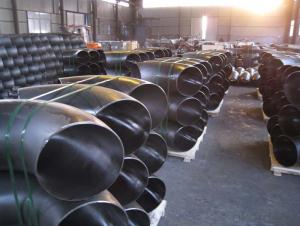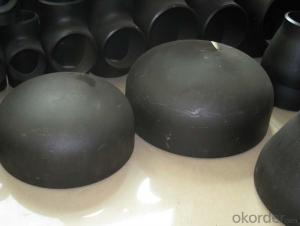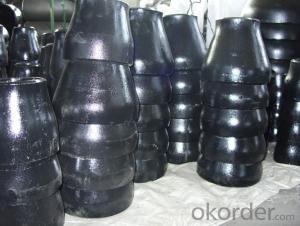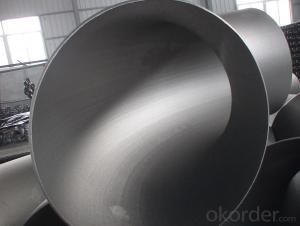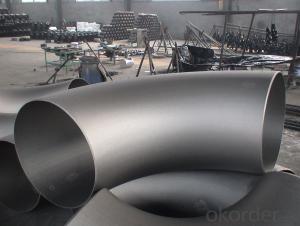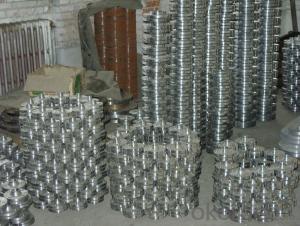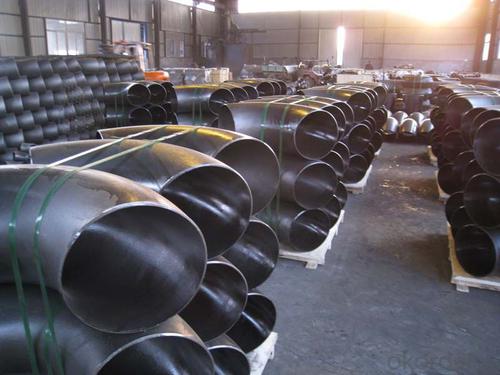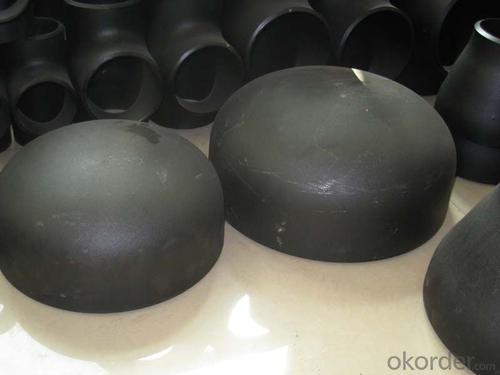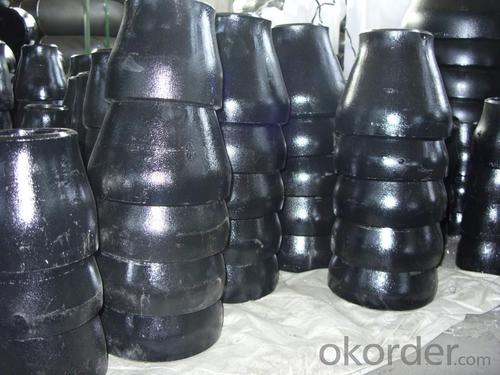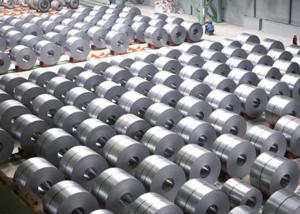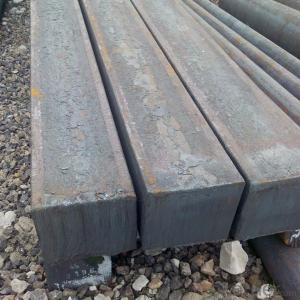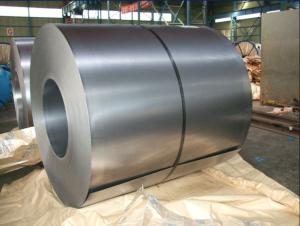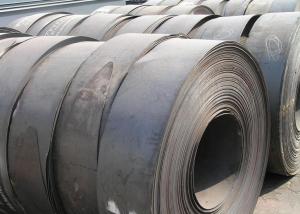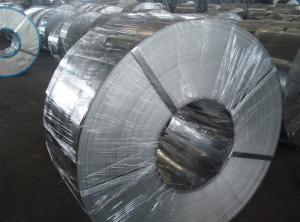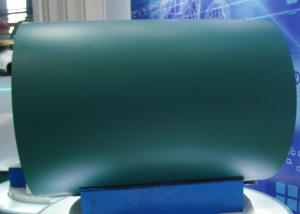Carbon Steel Pipe BEND 45DEG
- Loading Port:
- China Main Port
- Payment Terms:
- TT OR LC
- Min Order Qty:
- -
- Supply Capability:
- -
OKorder Service Pledge
OKorder Financial Service
You Might Also Like
Specifications
Specifications
pipe fitting elbow
Certificate:ISO:9001-2000
New material,completely meet asme and din standard
Best price
1. type: AISI ASTM A234 WPB BW Con Elbow
2. Size: 1/2"-48"(1/2"-24"is seamless and 26"-48"is welded)
3. Wall thickness: sch10-160, STD, XS, XXS
4. Material: A234WPB, A420WPL6, A420WP5, WP11, WP12, WP22, etc
5. Welding line: seamless
6. Angle of bend: 30, 45, 90, 180degree
7. Bending radius: SR, LR
8. Standard: ANSI B16.9, JIS, SB, DIN, GB
9. Surface treatment: black paint, vanis paint, black rust-proof oil,
transparent oil, hot galvanizing
10. Application: petroleum, electricity, chemical, natural gas, metallurgy,construction,
shipbuilding and other fields because of its high pressure, high temperature, etc
11. connection: welding
12. technics:forged
13.Certificate:ISO9001 - 2000, CE, SGS, etc.
14. packaging: wooden case, pallet, container or in accordance with the
requirement of customers
15. Principle: quality fist, customer first, credit first
16. payment: L/C T/T
17. delivery time: 7-25 days after payments
18. Notes: the bevel can be made in accordance with the special requirements
of the customers
19. Others: we can also produce the products according to the requirements
of the customers
The main production:
1. PIPE FITTINGS: elbows, tees, bends, reducers, cap, flanges and sockets etc.
2. PIPE: bult welded pipes, seamless pipes, threaded pipes, etc.
We sincerely welcom customers at home and abroad to visit us and seek common development.
- Q: What are the different types of steel bars?
- There are several different types of steel bars, including mild steel bars, deformed steel bars, high tensile steel bars, stainless steel bars, and alloy steel bars. Each type of steel bar has its own unique properties and uses in various industries and applications.
- Q: How is steel used in the construction of parking structures and garages?
- Steel is commonly used in the construction of parking structures and garages due to its strength, durability, and ability to support heavy loads. It is used for the framework, columns, beams, and decking, providing a sturdy and robust structure that can withstand the weight of vehicles and ensure the safety of the parking facility. Additionally, steel can be easily fabricated and erected, making it a popular choice in the construction industry for parking structures.
- Q: How is steel used in the production of tools and machinery?
- Steel is used in the production of tools and machinery due to its exceptional strength, durability, and versatility. It is commonly utilized to create blades, gears, bearings, and structural components that require high strength and resistance to wear and tear. Additionally, steel can be easily shaped and machined, making it ideal for manufacturing various types of tools and machinery.
- Q: What are the different types of steel gratings and stair treads available?
- There are several different types of steel gratings and stair treads available, including welded steel gratings, press-locked steel gratings, and swage-locked steel gratings. Welded steel gratings are made by welding steel bars together to form a strong and durable grid structure. Press-locked steel gratings have interlocking sections that are mechanically locked together, providing a secure and stable surface. Swage-locked steel gratings are manufactured by permanently attaching cross bars to bearing bars through a swaging process, resulting in a high-strength and aesthetically pleasing grating. Stair treads can be customized to fit different applications, and they often come with various nosing options for added safety and stability.
- Q: What are the properties of tool steel for precision cutting tools?
- Tool steel for precision cutting tools is known for its high hardness, wear resistance, and toughness. It has excellent dimensional stability, allowing for precise cutting and shaping. It also possesses good heat resistance, enabling it to withstand high temperatures without losing its hardness. Additionally, tool steel for precision cutting tools often has good edge retention and can be easily sharpened, making it ideal for long-lasting, accurate cutting performance.
- Q: How do steel products contribute to the telecommunications and networking industry?
- Steel products play a crucial role in the telecommunications and networking industry by providing the necessary infrastructure and support for the installation and operation of communication networks. Steel towers and structures are used to support antennas and satellite dishes, enabling the transmission of signals for wireless communication, internet connectivity, and broadcasting. Additionally, steel cables and wires are essential for the efficient transmission of data over long distances. Overall, steel products provide the strength, durability, and stability required for the seamless functioning of telecommunications and networking systems.
- Q: How are steel profiles used in the construction of underground tunnels?
- Steel profiles are commonly used in the construction of underground tunnels as they provide structural support and reinforcement. These profiles are used to create the tunnel lining, which helps to prevent the collapse of the surrounding soil or rock. Additionally, steel profiles can also be used as tunnel ribs or arches, distributing the load and ensuring stability. Overall, steel profiles play a crucial role in enhancing the strength and longevity of underground tunnels.
- Q: How is steel used in the production of bicycles and motorcycles?
- Steel is used in the production of bicycles and motorcycles mainly for their frames and other structural components. It provides strength, durability, and stability, making it an ideal material for these vehicles. Steel frames are known for their ability to absorb shocks and vibrations, ensuring a smooth and comfortable ride. Additionally, steel can be easily welded, allowing for intricate designs and customization options.
- Q: How are steel bars used in the construction of high-rise buildings?
- Steel bars, also known as rebar, are essential components in the construction of high-rise buildings. They are primarily used to reinforce concrete structures and provide the necessary strength and durability needed to withstand the immense loads and forces experienced by tall buildings. These steel bars are strategically placed within the concrete framework, creating a reinforced concrete structure that can resist bending, cracking, and collapsing under the building's weight and external pressures. The steel bars act as a backbone, distributing and transferring the loads throughout the structure, ensuring the safety and stability of the high-rise building.
- Q: What are the different types of steel angles and their applications in the manufacturing of machinery?
- There are several types of steel angles commonly used in the manufacturing of machinery. These include equal angles, unequal angles, and L-shaped angles. Equal angles have equal sides and are typically used for structural applications, such as frames and supports. They provide stability and strength to the machinery. Unequal angles have different sides and are used for specific purposes where additional strength or load-bearing capacity is required. These angles are commonly used in the construction of machinery components that need to withstand heavy loads or stress. L-shaped angles, also known as corner angles, are commonly used in machinery manufacturing to provide structural support and reinforcement. They can be used to reinforce corners, provide additional strength to joints, or create bracing for machinery components. Overall, the different types of steel angles play a crucial role in the manufacturing of machinery by providing structural support, stability, and reinforcement to ensure the durability and functionality of the machinery.
Send your message to us
Carbon Steel Pipe BEND 45DEG
- Loading Port:
- China Main Port
- Payment Terms:
- TT OR LC
- Min Order Qty:
- -
- Supply Capability:
- -
OKorder Service Pledge
OKorder Financial Service
Similar products
Hot products
Hot Searches
Related keywords
